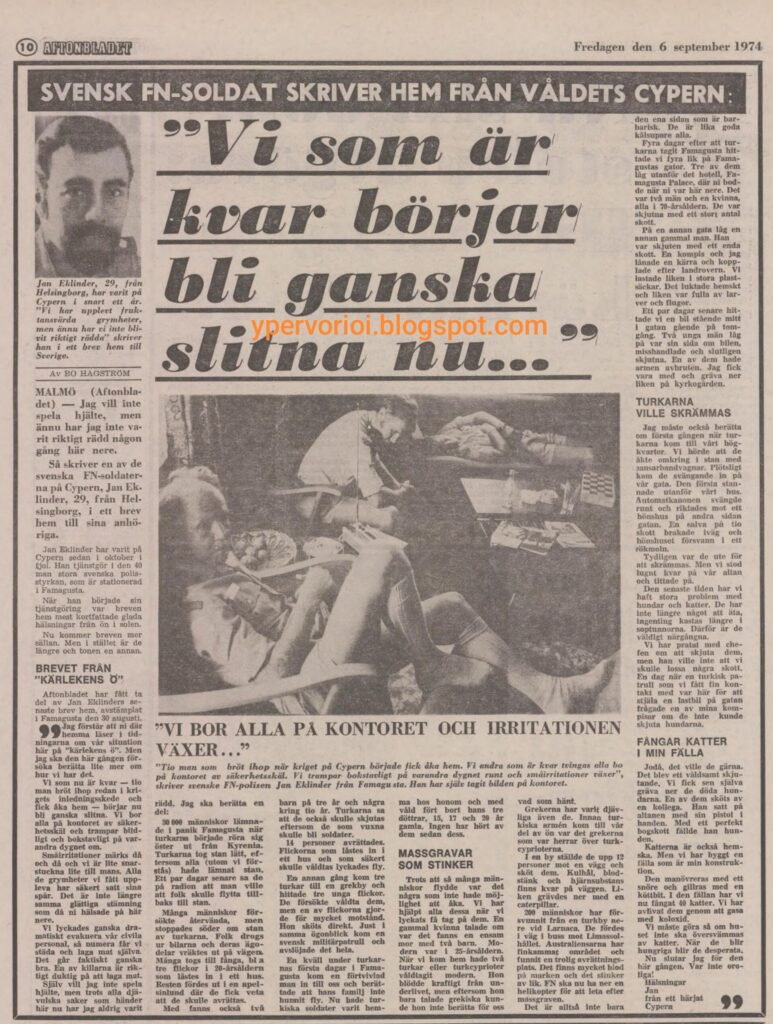Trigger warning: This article contains graphic descriptions of violence, sexual assault, and the killing of children during the 1974 invasion of Cyprus. Reader discretion is advised.
Nearly fifty years later, a harrowing testimony from 1974 has resurfaced, shedding new light on the Turkish atrocities and horrors of the Turkish invasion of Cyprus.
On 6 September 1974, the Swedish newspaper Aftonbladet published a letter from Jan Eklinder, a 29-year-old UN soldier stationed in Famagusta. In his correspondence to his family, Eklinder described in unflinching detail the atrocities he witnessed in the aftermath of the invasion- including rapes, executions, mass graves, and the unbearable daily task of collecting corpses from the streets.

Execution of children
Among the most shocking parts of the testimony is the execution of civilians, including children. According to Eklinder, a group of 14 people were rounded up by Turkish soldiers and led to an orange grove. Among them were two toddlers, just three years old, and several children around ten. The soldiers declared: “The children must also be executed, because when they grow up they will become soldiers.”
All fourteen were executed. Three young women, about 20 years old, were locked in a nearby house, and while Eklinder suggested they had been raped, they managed to escape.
Accounts of sexual violence
Eklinder’s letter also described further incidents of sexual violence. He wrote that three Turkish soldiers entered a Greek village and attempted to rape three young girls. When one resisted, she was executed on the spot. A Swedish patrol happened to arrive just in time to prevent further assaults.
On another occasion, a desperate father begged the peacekeepers for help after Turkish soldiers had abducted his three daughters, aged 15, 17, and 20. They were taken from his home by force. None were ever seen again.
Eklinder also described helping a 25-year-old mother of two who had been raped and was bleeding heavily from her injuries. She spoke only Greek and could not explain what had happened, but her condition told the story.
Violence on both sides
While most of his testimony focused on 1974 Turkish atrocities and actions, Eklinder also noted atrocities committed by Greek forces against Turkish Cypriots. He wrote of one village where twelve men were lined up against a wall and executed, their bodies buried with a bulldozer. Bullet holes, blood, and brain matter remained visible on the wall.
In another case, 200 Turkish Cypriots disappeared from a village near Larnaca. Transported by bus toward Limassol, they were never seen again. Australian peacekeepers later found evidence of a possible execution site, with blood on the ground and the smell of decomposing bodies.
The burden on peacekeepers
Eklinder explained that the remaining Swedish UN soldiers were left with the grim task of clearing corpses from the streets. He described collecting four bodies outside the Famagusta Palace Hotel, all elderly people who had been executed with gunfire, and another elderly man shot in the street. Using a wheelbarrow tied to a jeep, they transported the decomposing bodies in plastic bags, overwhelmed by the stench and the sight of maggots.
He also recalled finding an abandoned car with its passengers lying nearby- beaten and then executed. He personally helped bury them at the cemetery.
Terror and daily survival
The testimony reveals how fear and exhaustion marked every day. Eklinder wrote that 30,000 people fled Famagusta in panic when the Turkish forces advanced, leaving the city empty except for the UN. Although he insisted he never felt fear, he admitted the atrocities had left a deep mark on all the soldiers.
He also described intimidation tactics by Turkish forces, such as firing a burst of ten rounds into a chicken coop across the street from the UN compound.
Even mundane survival became difficult. With supplies cut off, the peacekeepers cooked for themselves and struggled with packs of stray dogs and cats, driven feral by hunger. Eklinder recounted how they trapped over forty cats with improvised snares and killed them with carbon monoxide to prevent being overrun.
A stark reminder
Eklinder’s letter, rediscovered decades later, paints an unflinching picture of the brutality of war and the suffering inflicted on civilians. His testimony stands as direct evidence of the 1974 Turkish atrocities in Cyprus, as well as the violence committed by Greek forces against Turkish Cypriots.
Above all, it remains a reminder of the devastating human cost of the Cyprus conflict and the trauma endured by both civilians and those sent to keep the peace.
Also read: 61 years since the deadly Tylliria bombing
For more videos and updates, check out our YouTube channel.


